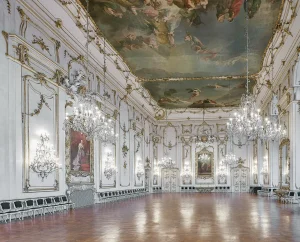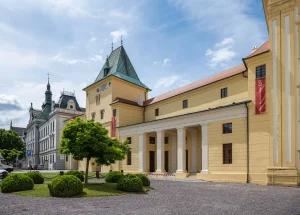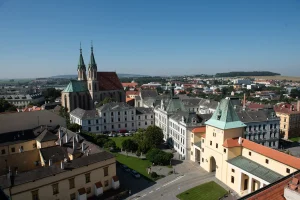Sněmovní náměstí (Assembly Square) in Kroměříž takes its name from the Constitutional Assembly of the Habsburg Monarchy, which was relocated from Vienna to Kroměříž during the turbulent revolutionary year of 1848.
Due to the revolution in Vienna, the imperial assembly was forced to suspend its meetings and look for a safer location. On the recommendation of František Palacký, the Archbishop’s Chateau in Kroměříž was chosen to host this historic event. Overnight, the city became the centre of European affairs, filled with ministers, soldiers, journalists, and above all, the assembly delegates who were working on a new constitution featuring strong democratic elements.
In December 1848, however, the young emperor Franz Joseph I ascended to the Austrian throne, crushed the uprising in Vienna, and prepared his own constitution. On 7 March 1849, he dissolved the inconvenient assembly in Kroměříž, occupied the town with the army, and dismissed the delegates. Although the Kroměříž constitution never came into force, it is still considered one of the foundational documents of parliamentary democracy in Europe.

This pivotal moment in Czech history inspired renowned graphic artist and designer of Czech banknotes Oldřich Kulhánek, who depicted František Palacký and the tower of the Kroměříž chateau on the 1,000 CZK banknote – the most common banknote in circulation today. Today, Sněmovní náměstí is home to the Archbishop’s Chateau, a UNESCO World Heritage Site. Its largest hall is aptly named Sněmovní sál (Assembly Hall) – the very room where delegates from across the monarchy once debated. Mlýnská Gate is the only surviving one of the original three gates that once provided access to the historic town. Today, it houses an interactive exhibition tracing the origins of the Archbishop’s Guard, dating back to the early 13th century. In addition to ceremonial duties during the bishops’ visits to the chateau, the guard also played an important role in maintaining public order.
The exhibition includes the commander’s apartment and facilities for the guard’s 20–30 members. Visitors can try on a guard’s uniform, test their aim, and explore the everyday life of the unit. The exhibition is open year-round, offering both individual and guided tours. During special events, visitors are guided by guards dressed in historical uniforms, adding an authentic touch to the experience – often accompanied by a cannon salute. One more detail is worth noting. On the facade of Mlýnská Gate, look for a surviving fragment of a mural bearing the Latin inscription CAROLVS VRBEM REPARARE STUDET (“The city carefully restored by Charles”) dated 1665, documenting the contribution of Bishop Karl II of Liechtenstein-Castelcorno to the reconstruction of Kroměříž.


